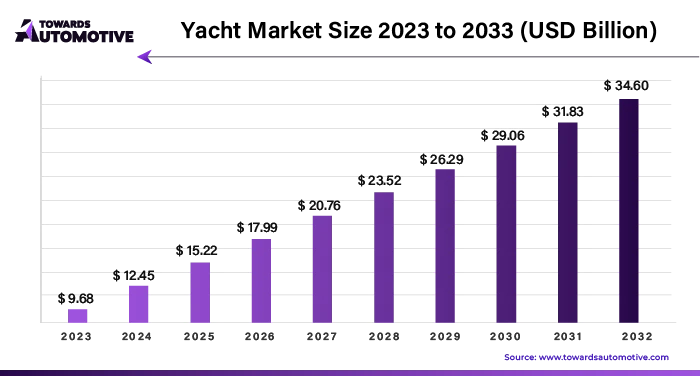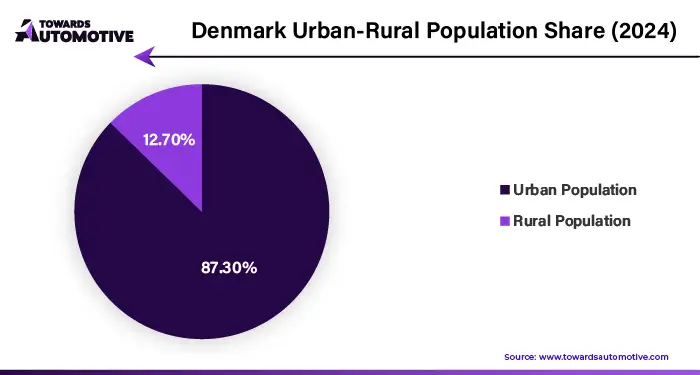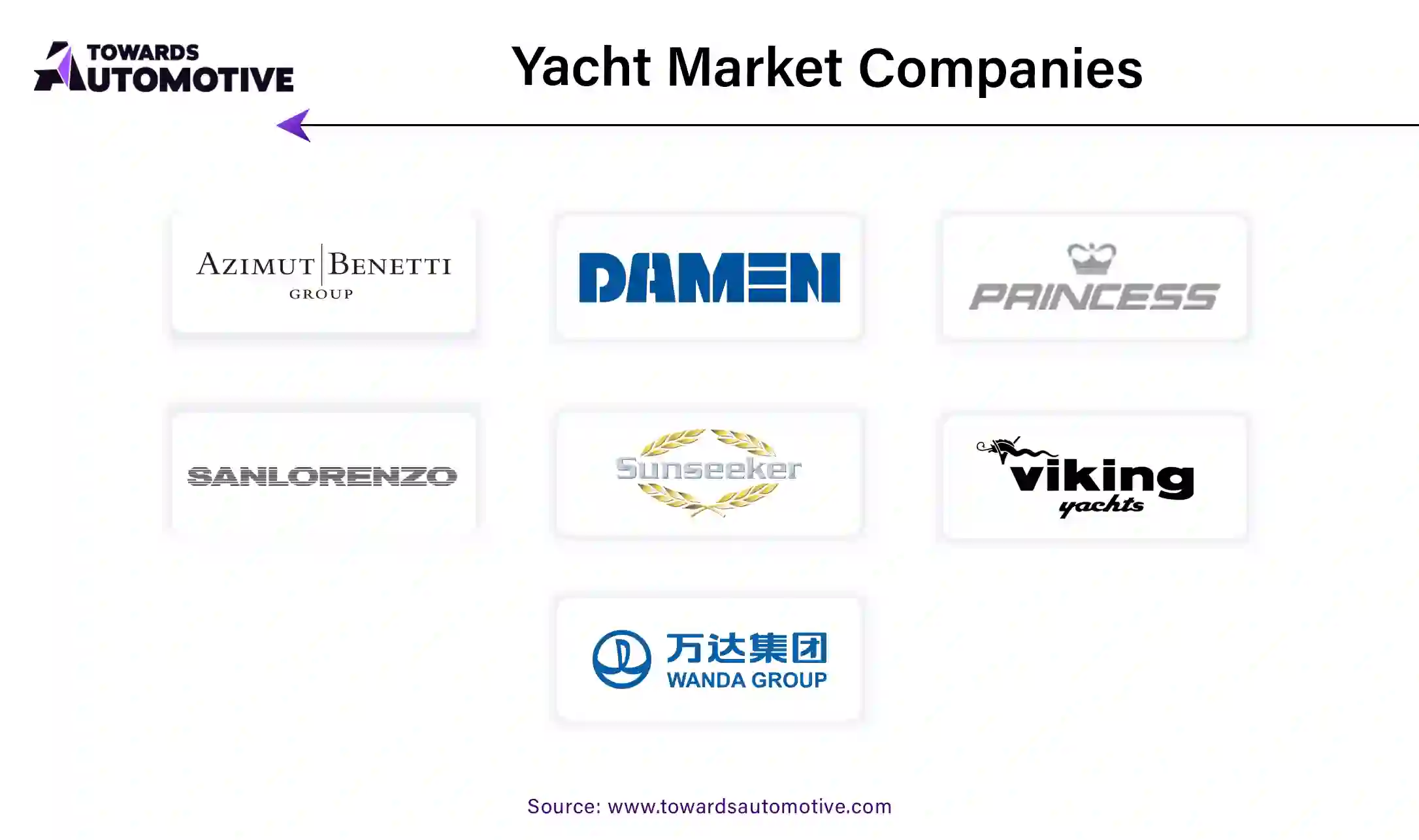April 2025
The global yacht market is projected to reach USD 33.77 billion by 2034, growing from USD 12.15 billion in 2025, at a CAGR of 12.03% during the forecast period from 2025 to 2034.

Unlock Infinite Advantages: Subscribe to Annual Membership
The yacht market is an important segment within the luxury goods industry, encompassing a wide range of vessels, from sleek and stylish motor yachts to traditional sailing yachts and the ultra-luxurious super yachts. It appeals to affluent individuals and enthusiasts who seek the ultimate in luxury, comfort, and adventure on the water. The global market is experiencing robust growth, driven by a combination of factors such as rising disposable incomes, an increasing number of high-net-worth individuals, and a growing desire for unique and exclusive experiences.
Technological innovations also play a crucial role in the market’s expansion. Advances in yacht design, eco-friendly propulsion systems, hybrid technologies, and enhanced navigation systems are making yachting more efficient and appealing to a broader audience. At the same time, sustainability is becoming a top priority, with many yacht buyers seeking greener alternatives, such as electric or hybrid yachts, to reduce their environmental impact.
Moreover, the growing popularity of yacht chartering offers a way for more people to experience the luxury of yachting without the hefty price tag of ownership. The ability to rent yachts for vacations or special events is helping to fuel the market by making yachting more accessible to a broader range of consumers.
AI plays a transformative role in the yacht market by enhancing efficiency, personalization, diagnostics and safety. Advanced AI systems help in smart navigation by optimizing routes based on weather, sea conditions and others, thereby enhancing the fuel efficiency. Also, AI-driven automation streamlines onboard systems and provides seamless control over lighting, climate and some other conditions. Additionally, AI enhances safety with advanced surveillance and collision avoidance systems along with helps in automatic diagnostics. By integrating these technologies, the yacht industry has achieved higher performance, sustainability, and gained prominent customer satisfaction.
The long-range yacht segment is a key driver of growth in the yacht market. These yachts are designed for extended voyages and equipped with advanced navigation systems, spacious interiors, and robust fuel systems, allowing for long-distance cruising without the need for frequent refueling. The ability to travel across oceans and explore remote, exotic destinations is a major attraction for owners who value both independence and luxury.
The segment's growth is also fueled by the increasing demand for experiential luxury, with long-range yachts offering bespoke experiences such as private island visits, remote scuba diving locations, and luxurious onboard entertainment. These yachts often feature state-of-the-art amenities such as spas, gyms, and cinema rooms, catering to clients seeking an all-inclusive vacation experience.
Technological innovations, including fuel-efficient engines, hybrid propulsion systems, and advanced energy management solutions, have also contributed to the growth of the long-range yacht segment. These innovations enhance the appeal of long-range yachts, as they provide extended cruising capabilities while minimizing the environmental impact, making them an attractive option for eco-conscious buyers. As the desire for global exploration and sustainable luxury grows, the long-range yacht segment continues to drive expansion within the yacht market.
The yacht market is significantly restrained by a lack of skilled workforce and high maintenance costs. Operating and maintaining yachts require specialized knowledge but a shortage of trained professionals limits efficiency and raises operational challenges in the yacht market. Additionally, the high costs associated with repairs, spare parts, and regular maintenance is another restraining factor that hampers the industrial expansion.
The rising awareness regarding electric yachts has gained traction in recent times. These yachts leverage advanced technology and electric propulsion systems for reducing carbon emissions and noise pollution that in turn shapes the industry in a positive direction. The growing demand for eco-friendly alternatives among rich buyers and charter clients has positioned electric yachts as a preferred choice in the evolving market. Additionally, increase in battery capacity and developments in charging infrastructure has improved the performance and range of electric yachts, thereby boosting the market expansion. Moreover, governments and regulatory bodies further support electric yachts by incentivizing sustainable marine technologies and creating awareness among consumers. Thus, advancement in technologies, government initiatives, improved battery capacity and some others has increased the demand for electric yachts that is expected to create numerous opportunities for the market players in the upcoming days.
The super yacht segment held the largest share of the market. Super yachts are a major driver of growth in the yacht market that caters to the high-net-worth individuals seeking ultimate luxury, exclusivity, and personalized experiences. These luxury vessels offer unmatched comfort and features such as spacious living areas, state-of-the-art technology, private spas, and helicopter pads. The demand for super yachts continues to rise as elite consumers have started to invest in super yachts for personal use and charter purposes. Additionally, technological advancements in hybrid engines and energy-efficient systems are making super yachts more appealing and future-proof among consumers. The increasing popularity of super yacht charter services in prime destinations such as the Mediterranean and Caribbean, also drives market growth.
The 20-50 m segment dominated the industry. The 20-50 meter yacht segment is a key growth driver in the yacht market that offers a suitable balance between luxury, performance, and accessibility. These yachts cater to affluent individuals seeking a manageable, cost-effective alternative to larger super yachts. With a range of advanced amenities, such as spacious cabins, high-end entertainment systems, and sophisticated design, 20-50 meter yachts attract both owners and charter clients. The size of these yachts allows for greater maneuverability, making them suitable for both private use and commercial charter operations, which are increasingly popular in high-demand regions like the Mediterranean and the Caribbean. As they are more affordable to operate and maintain than larger super yachts, these mid-size yachts appeal to a broader demographic of wealthy buyers, driving market expansion. Furthermore, the increasing focus on sustainability and innovative technologies in this segment, such as hybrid propulsion systems, makes these yachts a more environmentally conscious choice, further boosting their appeal.
The motor yacht segment led the industry. Motor yachts are a significant driver of growth in the yacht market that offers a combination of luxury, performance, and convenience that appeals to a broad range of consumers. Motor yachts provide faster travel, greater comfort, and an easier cruising experience, making them popular among young consumers. Their powerful engines allow longer voyages, making it ideal for leisure trips as well as luxury charters, which are particularly in demand in top coastal destinations. The motor yacht segment also benefits from increasing innovations in design, fuel efficiency, and onboard technology, attracting tech-savvy and environmentally conscious buyers. Many motor yachts are equipped with state-of-the-art amenities such as advanced navigation systems, luxurious interiors, and energy-efficient features, enhancing the overall yachting experience. As a result, motor yachts continue to dominate the market, driving demand in both the private ownership and charter sectors.
Europe dominated the yacht market. The yacht market in this region is driven by several factors such as rise in number of wealthy people, urbanization, rising interest in eco-friendly yachts, numerous yachting events and some others. Europe is home to a significant number of high-net-worth individuals (HNWIs), particularly in countries such as the United Kingdom, Monaco, France, and Germany. This wealthy demography drives demand for luxury yachts such as super yachts, motor yachts, and sailing yachts.
European consumers are increasingly interested in sustainable and eco-friendly solutions, which has driven the demand for hybrid and electric yachts. The adoption of green technologies and sustainable designs is helping attract environmentally conscious buyers, further expanding the market.
Urbanization plays a key role in driving the growth of the yacht market in Europe. As cities expand and wealth concentrates in urban areas, more affluent individuals are seeking leisure and luxury experiences, including yachting. Coastal cities such as Spain, Denmark, Greenland and some others are becoming hubs for yacht ownership and chartering. The increasing demand for recreational activities and exclusive waterfront experiences is pushing the expansion of marinas, yacht clubs, and associated infrastructure. Urbanization also brings enhanced accessibility to these luxury experiences, fueling the growth of the yacht market as more people in cities aspire to own or charter yachts.
European yacht shows such as the Monaco Yacht Show and the Cannes Yachting Festival, serve as major events for the industry. These events showcase the latest yacht designs, innovations, and technologies, drawing attention from potential buyers and investors worldwide and contributing to the growth of the market.

Asia Pacific is expected to grow with the highest CAGR during the forecast period. The yacht market in Asia Pacific region is generally driven by the rising interest in marine tourism, rise in yacht chartering, government support and some others. As tourism continues to flourish in coastal areas of Asia, such as Southeast Asia, the Philippines, and the South Pacific, yachting and luxury charters are becoming increasingly popular. Destinations such as Thailand, Malaysia, and the Maldives are attracting yacht tourists, driving the demand for both private yachts and charter services.
Also, the rise in yacht chartering is a major contributor to market growth, allowing individuals to experience the luxury of yachting. With expanding charter fleets and increasing numbers of affluent tourists, yacht chartering is gaining popularity in countries such as Thailand, Indonesia, and Hong Kong which in turn drives the market expansion.
Moreover, governments of several APAC countries are supporting the yacht industry with favorable regulations, incentives, and tax breaks that attract yacht owners, manufacturers, and investors. In countries such as Singapore and Hong Kong, favorable tax policies and simplified regulations for yacht ownership contribute to the sector’s expansion.

By Type
By Length
By Propulsion
By Region
April 2025
April 2025
April 2025
April 2025
Dr. Arjun Patel is a distinguished expert in the automotive industry, holding advanced degrees in Automotive Engineering and Mechanical Engineering. His expertise spans automotive market dynamics, technological advancements, and sustainable practices. Dr. Patel excels in conducting in depth research and analysis on market trends, consumer preferences, and the economic implications within the automotive sector. He is renowned for his insightful publications on topics such as electric vehicles, autonomous driving technologies, and the evolution of sustainable transportation solutions. Dr. Patels research contributions have significantly advanced understanding in the field, earning him recognition as a leading authority in automotive research and analysis.
We offer automotive expertise for market projections and customizable research, adaptable to diverse strategic approaches.
Contact Us